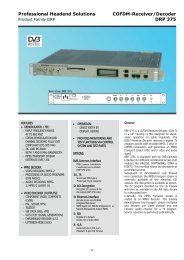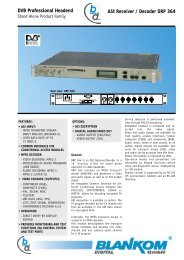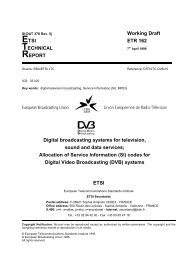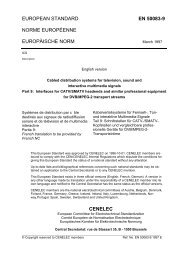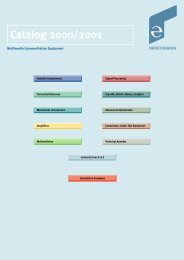Digital Video Broadcasting (DVB); User guidelines for Digital ...
Digital Video Broadcasting (DVB); User guidelines for Digital ...
Digital Video Broadcasting (DVB); User guidelines for Digital ...
You also want an ePaper? Increase the reach of your titles
YUMPU automatically turns print PDFs into web optimized ePapers that Google loves.
• Transmit DSNG transportable earth station characteristics:<br />
• Location: at beam edge and at beam centre<br />
• Φ = 0.9, 1.2, 1.5 and 1.8 m (65 % antenna efficiency, 0.3 dB coupling losses, 0.3dB<br />
pointing losses) equipped with TWT of 250 W.<br />
• Maximum operational EIRP (<strong>for</strong> 3 dB OBO) = 67 dBW <strong>for</strong> 1.8 m, 65 dBW <strong>for</strong> 1.5 m, 63<br />
dBW <strong>for</strong> 1.2 m and 60 dWB <strong>for</strong> 0.9 m)<br />
• Receive earth station characteristics <strong>for</strong> DSNG transmissions:<br />
• Location: at beam edge and at beam centre<br />
• Φ = 2.4 m (G/T = 25 dB/k); 4.5 m (G/T = 30 dB/k) and 8.1 m (G/T = 35 dB/k)<br />
• 65% antenna efficiency, 0.3 coupling losses, 0.5 pointing losses, 1.2 dB noise figure<br />
• Earth station characteristics <strong>for</strong> fixed contribution links:<br />
• Φ = 8.1 m, 4.5 and 2.4 m<br />
• Total (TWT)OBO = 2 dB <strong>for</strong> QPSK and 8PSK, and 6 dB <strong>for</strong> 16QAM<br />
• Maximum operational EIRP = ≤80 dBW<br />
• G/T = 35 dB/k <strong>for</strong> 8.1 m, 30 dB/k <strong>for</strong> 4.5 m and 27 dB/k <strong>for</strong> 2.4 m.<br />
• Satellite characteristics:<br />
• G/T= 5.5 dB/K at beam centre (-0.5 dB/K at beam edge)<br />
• EIRP (at saturation) = 50 dBW at beam centre (42 dBW at beam edge)<br />
IPFD=-85.5 dBW/m 2 (Nominal setting) at beam centre (-79.5 dBW/m 2 at beam edge) . For<br />
the fixed contribution links using (16QAM) it is considered the operation of the<br />
transponder in 3dB lower gain conditions.<br />
• Simplified link budgets considering a total degradation of 2dB due to all sources of interference<br />
(crosspolar and adjacent channels, intermodulation, non linearities, etc.)<br />
• Other assumptions are:<br />
• Reference satellite orbital location: 0ºE<br />
• Uplink frequency: 14.25 GHz<br />
• Downlink frequency :11.75 GHz<br />
• Sea level height <strong>for</strong> the transmit and receive earth stations: 100 m<br />
• Atmospheric absorption: (0.3 dB <strong>for</strong> uplink and 0.2 dB <strong>for</strong> the downlink)<br />
• Worst case polarisation (Linear horizontal)<br />
2.4.2. DSNG Examples<br />
Figures 1, 23, and 4 summarises the results in terms of clear sky margins obtained <strong>for</strong> the DSGN<br />
links using the above hypothesis.<br />
Figures 1.1, 2.1, 3.1 and 4.1 includes the results <strong>for</strong> the beam edge to beam edge links and figures<br />
1.2, 2.2, 3.2 and 4.2 are <strong>for</strong> the beam centre to beam centre links.<br />
In these graphics it is indicated as reference, the estimated margin required <strong>for</strong> the 99.9% and 99.75<br />
% link availability corresponding to the ITU hidrometheorological zones K and H .<br />
For example, if the required availability is 99.9 % and the transmission is made from zone H using<br />
1.8 m as transportable earth station (max. EIRP of 67 dBW), and 8.1m as receiving earth station,<br />
both located at beam edge, it is possible to transmit a maximum useful data rate of 12.29 Mb/s in a 9<br />
MHz slot using 8PSK 2/3 modulation scheme. In the same conditions of availability, zone and<br />
receiving earth station, if the transmit earth station is 1.2 m ( max. EIRP of 63dBW), the maximum<br />
useful data rate is 9.22 Mb/s in a 9 MHz slot using QPSK 3/4 modulation scheme.<br />
15





